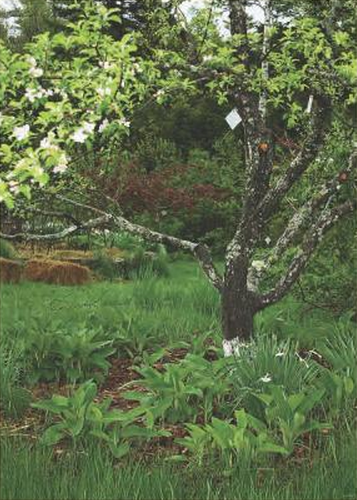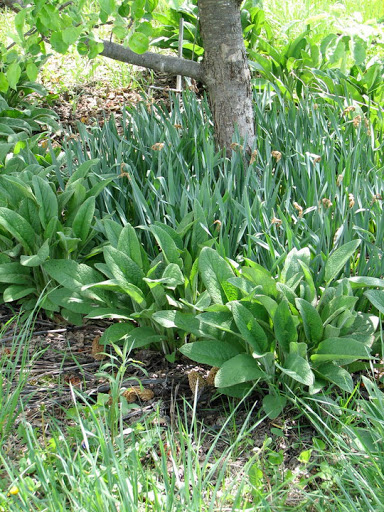|
|
Post by MikeH on Feb 12, 2013 18:45:03 GMT -5
When this subject came up as the subject of this thread, I posted this: Kourik's book shows this:  Cocannouer's book has no references nor a bibliography. Hill's article, while having a bibilography has no footnotes and no indication of the source of the charts used. I wasn't able to find any of the other sources cited. But then I remembered Dr. James Duke's Phytochemical and Ethnobotanical Databases. Starting with Wiki's list of plant nutrients, I searched Duke's database for those plants with the highest concentrations of each of the nutrients. It's a surprising short list of plants - Lambsquarter, Pigweed, Stinging Nettle, Dandelion, and Red Clover. Note that the list is assembled based on perennials that are hardy to US Zone 4b. Lists can be assembled according to one's climate. I plan to use this information to build a specific tea rather than a general compost tea. Attachments:
|
|
|
|
Post by raymondo on Feb 20, 2013 16:38:38 GMT -5
What file type is the attachment Mike? My computer doesn't recognize it.
|
|
|
|
Post by MikeH on Feb 20, 2013 17:03:39 GMT -5
What file type is the attachment Mike? My computer doesn't recognize it. Neither does mine. It's an Excel file. Try renaming it by adding ls after the x. That worked for me. I've uploaded it again. Hopefully it's OK this time. Regards, Mike Attachments:
|
|
|
|
Post by MikeH on Feb 20, 2013 17:15:40 GMT -5
|
|
|
|
Post by raymondo on Feb 21, 2013 5:15:42 GMT -5
Thanks Mike. I changed it to .xls and it's fine. Some interesting stuff there. If you grew mallow, pigweed and a stinging nettle you'd be doing pretty well nutrient-wise! I am surprised at how much Si that stinging nettle manages to collect from its environment.
|
|
|
|
Post by MikeH on Feb 21, 2013 6:12:33 GMT -5
Thanks Mike. I changed it to .xls and it's fine. Some interesting stuff there. If you grew mallow, pigweed and a stinging nettle you'd be doing pretty well nutrient-wise! I am surprised at how much Si that stinging nettle manages to collect from its environment. Yeh, I was quite surprised. The other thing that I noticed is that comfrey does not score well on soil micronutrients. When I dig through the online journals, all but 2 of the 92 online journal references that I can find are about toxicity. One evaluates comfrey as a forage crop for silage. The other is a couple of paragraphs in Nature in 1955 about Lawrence Hill's 1954 study. That's not to say that Hill's work is not well founded but only that it seems to be the basis for all horticultural claims about comfrey. BTW, I sorted the data for perenniality and for my climate. I excluded plants that would not overwinter for me. For more temperate climates where winters are not as harsh, there are may be additional plants. It's worth going to each of the micronutrient tabs and taking a look at what plants are available. |
|
|
|
Post by richardw on Feb 27, 2013 13:17:17 GMT -5
Its the dandelion that comes out well on that soil micro nutrients chart.
How does comfrey do where you are Mike?
|
|
|
|
Post by MikeH on Mar 3, 2013 5:35:31 GMT -5
How does comfrey do where you are Mike? Quite well. We've been growing the Bocking 14 variety from Richters. It's sterile so we don't have seeded volunteers. It's been very well-behaved, ie, has stayed put. We're planning a large subdivision so that we can start to change how we grow our fruit and nut trees. This picture from Michael Phillips' book The Holistic Orchard shows comfrey and daffodils planted around a fruit tree. The brown is not soil but ramial wood chips. He's assembling a natural "system" tailored to support the fruit tree. Comfrey mines minerals deep in the soil. Comfrey attracts insects. Daffodils repel rodents and deer just at the time that tender shoots are emerging. Ramial wood chips are part of fungal duff management. Fungal duff refers to the decaying organic matter and fungal community living beneath a tree. Whereas many standard agricultural practices, even in the organic world, tend to tip the balance toward a bacteria-dominated environment, the best spot for a fruit tree is one that mimics forest edge conditions, where the fungal biomass in the soil outweighs the bacterial biomass by a factor of 10 or more. This is the mycorrhizal fungi work of Elaine Ingham applied in a different way.  There's a picture in Mark Shepard's Restoration Agriculture that is very similar to Phillips'. Phillips grows apples on 58 acres. Shepard's is a far more complex natural system on 106 acres. It's a commercial-scale, perennial agricultural ecosystem using oak savannah, successional brushland and eastern woodlands as the ecological models using windbreaks, alleycropping, riparian zones, forest farming, silvopasture and polyculture systems. I would highly recommend both books. Phillips opens your eyes but Shepard opens your head. And Phillips is a funny man: "I like to think everyone has a particularly valuable bit to contribute to society. Here's mine. Those guys chipping that brush get mighty thirsty after a day's work. Offering them a six-pack of cold beer in appreciation for the truck coming by with a load of ramial wood chips gets their attention. And if it turns out one of your neighbors also bought this book - and thus is savvy to biological value - then up the ante. Offer a better brand of beer!" Shepard is outspoken in a different way. He's a permaculturalist who upsets permaculturalists: " While permaculturists by the thousands install sheet-mulched mandala gardens with visions of feeding themselves and the world, set up plastic hoop houses to grow greens or connect gutters to rain barrels to grow a few fish, they still all sit down to lunch and dine on the most unsustainable staple food crops ever devised by humankind: annual grains and legumes — rice, wheat, beans, lentils, corn and so on." But he's got a funny side too: "There are very few records of beech being planted in former agricultural land, so stealing beechnuts from the cute starving chipmunks looks like our only option to harvest them as staple foods. Where are you beechnut farmers and beechnut breeders?" |
|
|
|
Post by MikeH on Mar 3, 2013 6:32:45 GMT -5
Shephard's Farm on Google Map   apple, currant, grape, hazelnut, chestnut, rugosa rose, daffodil, iris and comfrey  Closeup of the bottom of the above picture |
|
|
|
Post by steev on Mar 3, 2013 22:32:38 GMT -5
Admirably free-form. The morels alone say he's doing something very right.
|
|
|
|
Post by MikeH on Mar 3, 2013 22:43:33 GMT -5
Admirably free-form. The morels alone say he's doing something very right. Not free form at all but spectacular nonetheless. He's following land contours to control flooding runoff and capture water. He uses something called keyline design. Seems to me that the morels say he's doing a lot of things right. |
|
|
|
Post by davida on Mar 3, 2013 23:18:31 GMT -5
|
|